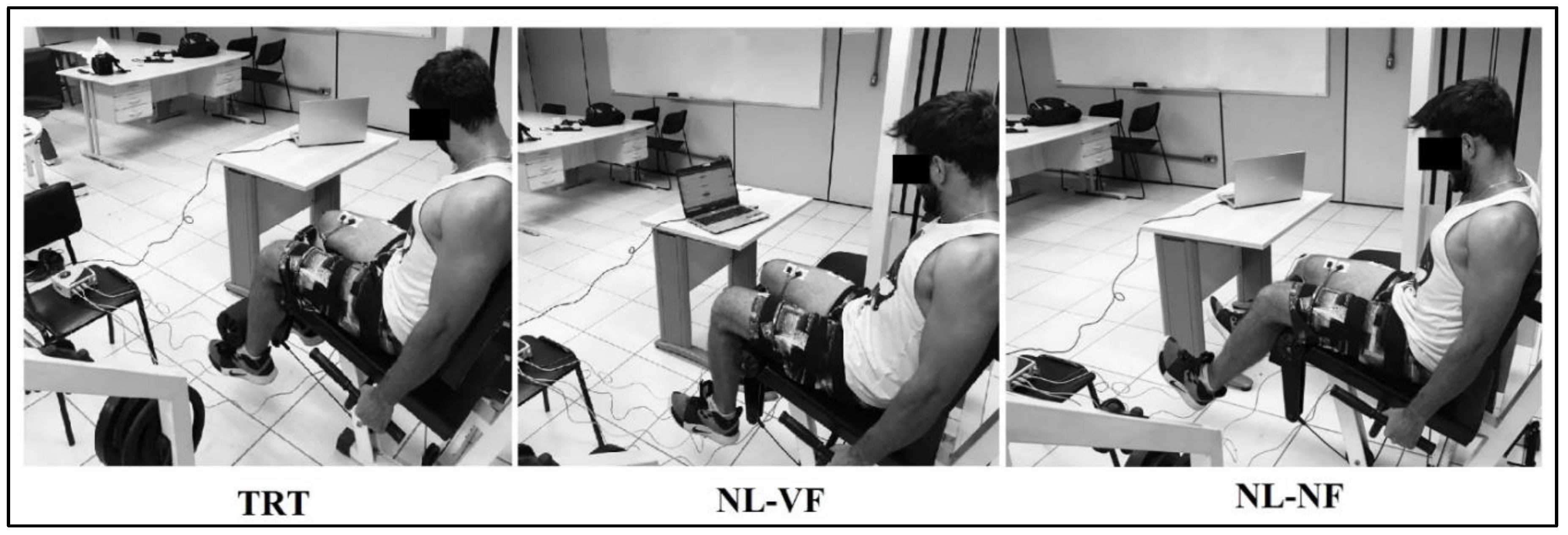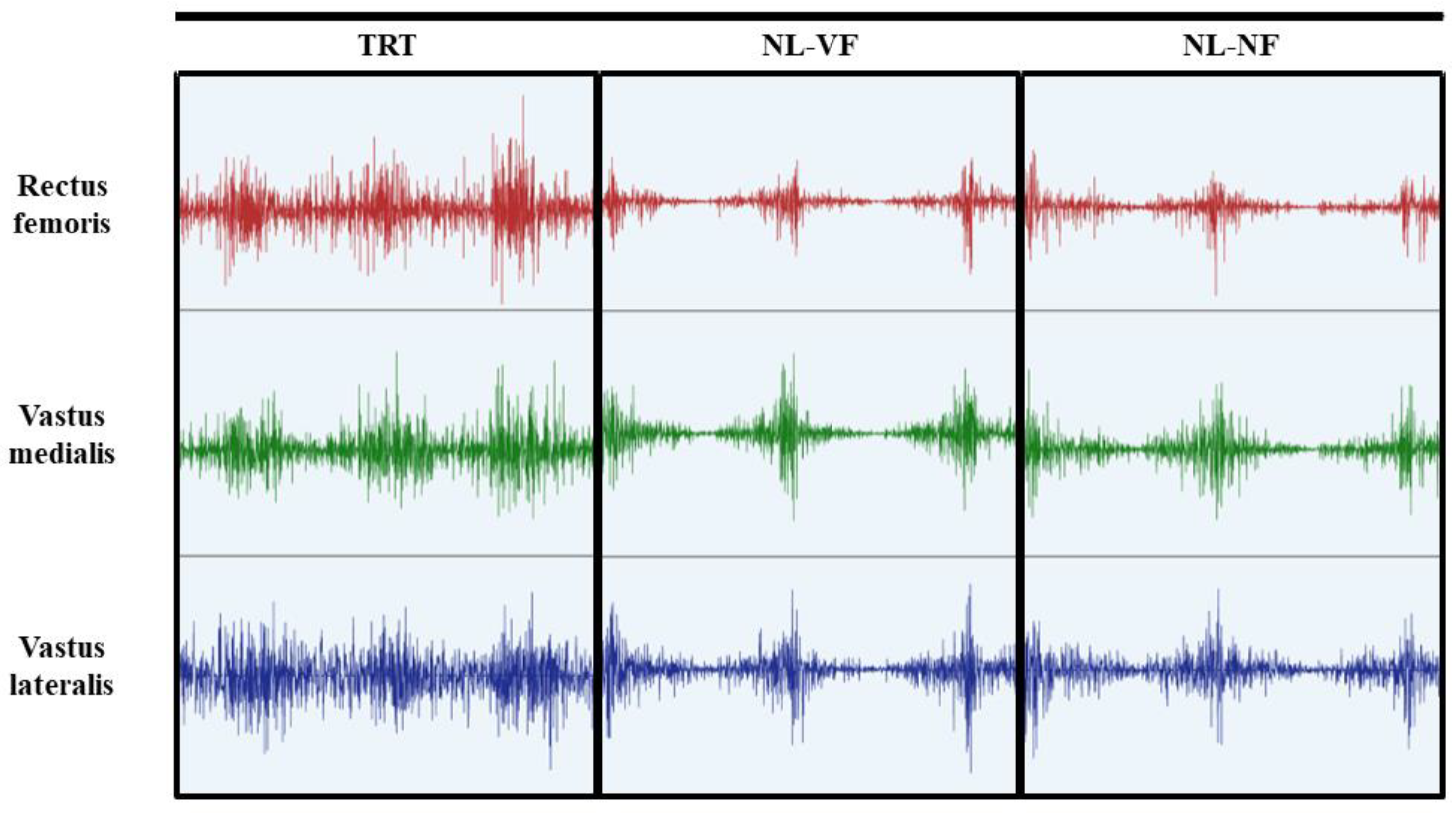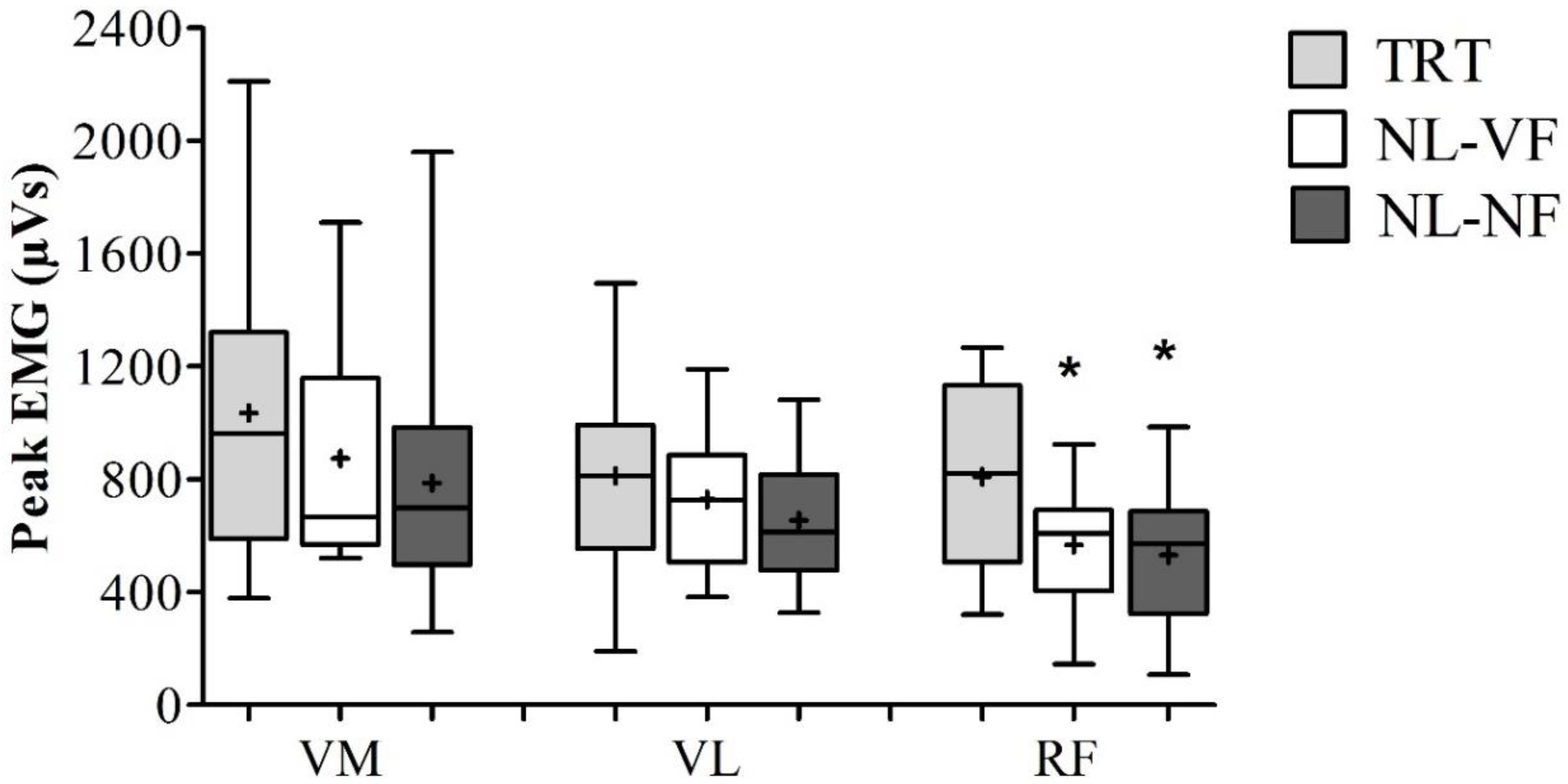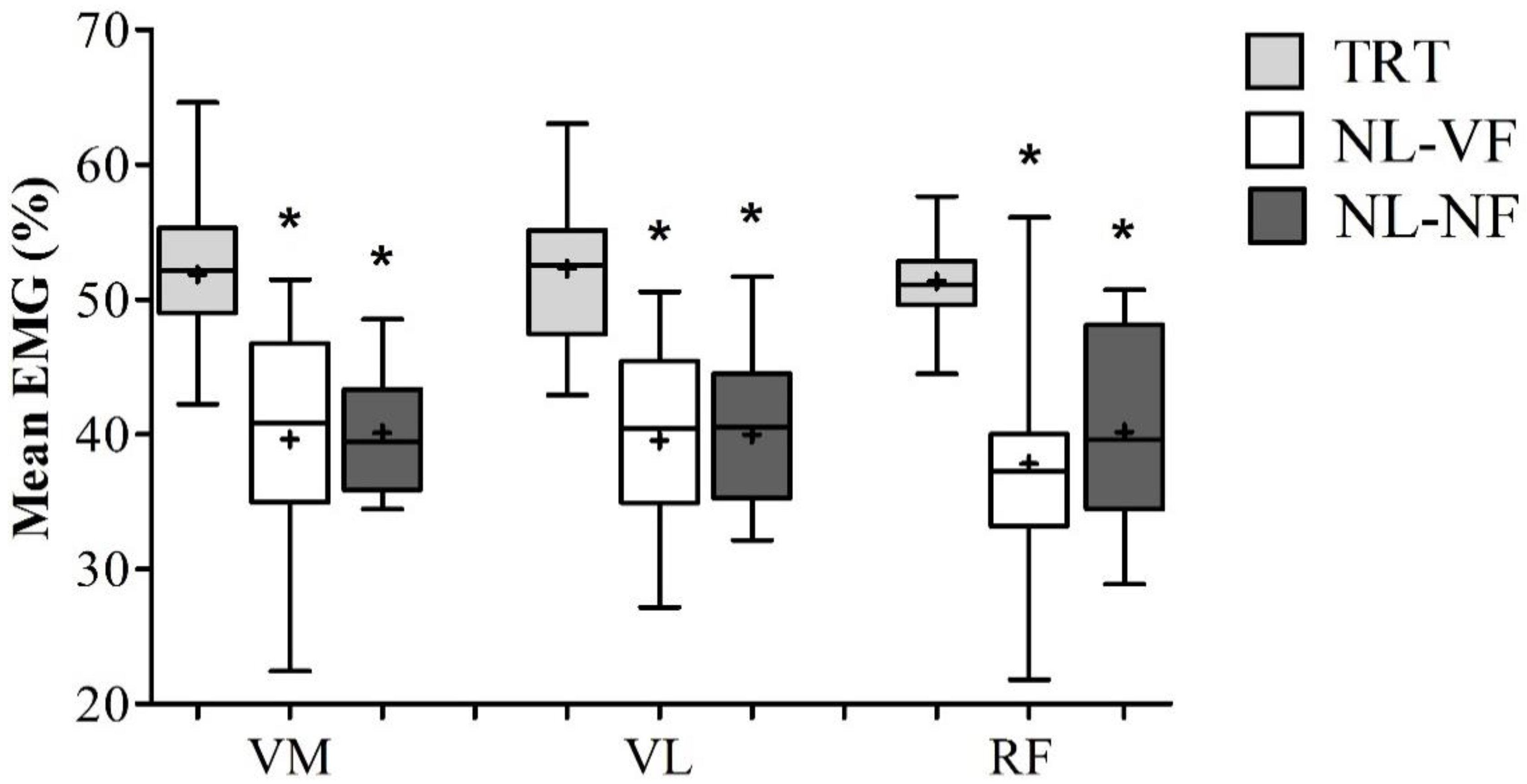“NO LOAD” Resistance Training Promotes High Levels of Knee Extensor Muscles Activation—A Pilot Study
Abstract
1. Introduction
2. Materials and Methods
2.1. Study Design
2.2. Subjects
2.3. Ten Repetitions Maximum (10 RM) Test
2.4. Experimental Procedures
- TRT involved the performance of a set to momentary muscle failure, as previously defined [19], using the 10 RM load and with the same procedures described in the 10 RM test. The repetitions were performed with a predetermined cadence of 2 s for both concentric and eccentric phases and no pause between phases. The set was interrupted when the participant was unable to adhere with the stablished cadence [27] or could not move the load.
- NL-NF involved the performance of 10 repetitions with no external load. The exercise was performed with the intention to maximally contract the muscles during the whole set at a cadence of 2 s for both the concentric and eccentric phases, with no rest between phases.
- NL-VF involved the same procedure as NL-NF, but a monitor was positioned in front of the participants to provide visual feedback on the EMG activity.
2.5. Electromyographic Activity
2.6. Statistical Analysis
3. Results
4. Discussion
Author Contributions
Funding
Conflicts of Interest
References
- Fisher, J.; Steele, J.; Smith, D. Evidence-based resistance training recommendations for muscle hypertrophy. Med. Sport. 2013, 17, 217–235. [Google Scholar] [CrossRef]
- Morton, R.W.; Colenso-Semple, L.; Phillips, S.M. Training for strength and hypertrophy: An evidence-based approach. Curr. Opin. Physiol. 2019, 10, 90–95. [Google Scholar] [CrossRef]
- American College of Sports Medicine (ACSM). American college of sports medicine position stand. Progression models in resistance training for healthy adults. Med. Sci. Sports Exerc. 2009, 41, 687–708. [Google Scholar] [CrossRef]
- Merico, A.; Cavinato, M.; Gregorio, C.; Lacatena, A.; Gioia, E.; Piccione, F.; Angelini, C. Effects of combined endurance and resistance training in Amyotrophic Lateral Sclerosis: A pilot, randomized, controlled study. Eur. J. Transl. Myol. 2018, 28, 7278. [Google Scholar] [CrossRef] [PubMed]
- Martorelli, S.; Cadore, E.L.; Izquierdo, M.; Celes, R.; Martorelli, A.; Cleto, V.A.; Alvarenga, J.G.; Bottaro, M. Strength training with repetitions to failure does not provide additional strength and muscle hypertrophy gains in young women. Eur. J. Transl. Myol. 2017, 27, 6339. [Google Scholar] [CrossRef]
- Celes, R.; Bottaro, M.; Cadore, E.; Dullius, J.; Schwartz, F.; Luzine, F. Low-load high-velocity resistance exercises improve strength and functional capacity in diabetic patients. Eur. J. Transl. Myol. 2017, 27. [Google Scholar] [CrossRef]
- McDonagh, M.J.; Davies, C.T. Adaptive response of mammalian skeletal muscle to exercise with high loads. Eur. J. Appl. Physiol. Occup. Physiol. 1984, 52, 139–155. [Google Scholar] [CrossRef]
- Assunção, A.R.; Bottaro, M.; Ferreira-Junior, J.B.; Izquierdo, M.; Cadore, E.L.; Gentil, P. The chronic effects of low- and high-intensity resistance training on muscular fitness in adolescents. PLoS ONE 2016, 11, e0160650. [Google Scholar] [CrossRef]
- Mitchell, C.J.; Churchward-Venne, T.A.; West, D.W.D.; Burd, N.A.; Breen, L.; Baker, S.K.; Phillips, S.M. Resistance exercise load does not determine training-mediated hypertrophic gains in young men. J. Appl. Physiol. 2012, 113, 71–77. [Google Scholar] [CrossRef]
- Morton, R.W.; Oikawa, S.Y.; Wavell, C.G.; Mazara, N.; McGlory, C.; Quadrilatero, J.; Baechler, B.L.; Baker, S.K.; Phillips, S.M. Neither load nor systemic hormones determine resistance training-mediated hypertrophy or strength gains in resistance-trained young men. J. Appl. Physiol. 2016, 121, 129–138. [Google Scholar] [CrossRef]
- Farup, J.; De Paoli, F.; Bjerg, K.; Riis, S.; Ringgard, S.; Vissing, K. Blood flow restricted and traditional resistance training performed to fatigue produce equal muscle hypertrophy. Scand. J. Med. Sci. Sports 2015, 25, 754–763. [Google Scholar] [CrossRef] [PubMed]
- Souza, D.; Barbalho, M.; Vieira, C.A.; Martins, W.R.; Cadore, E.L.; Gentil, P. Minimal dose resistance training with elastic tubes promotes functional and cardiovascular benefits to older women. Exp. Gerontol. 2019, 115, 132–138. [Google Scholar] [CrossRef] [PubMed]
- Colado, J.C.; Garcia-Masso, X.; Pellicer, M.; Alakhdar, Y.; Benavent, J.; Cabeza-Ruiz, R. A comparison of elastic tubing and isotonic resistance exercises. Int. J. Sports Med. 2010, 31, 810–817. [Google Scholar] [CrossRef] [PubMed]
- Kikuchi, N.; Nakazato, K. Low-load bench press and push-up induce similar muscle hypertrophy and strength gain. J. Exerc. Sci. Fit. 2017, 15, 37–42. [Google Scholar] [CrossRef]
- Takahashi, A.; Imaizumi, H.; Hayashi, M.; Okai, K.; Abe, K.; Usami, K.; Tanji, N.; Ohira, H. Simple resistance exercise for 24 weeks decreases alanine aminotransferase levels in patients with non-alcoholic fatty liver disease. Sports Med. Int. Open 2017, 1, E2–E7. [Google Scholar] [CrossRef]
- Ozaki, H.; Loenneke, J.; Thiebaud, R.; Abe, T. Cycle training induces muscle hypertrophy and strength gain: Strategies and mechanisms. Acta Physiol. Hung. 2015, 102, 1–22. [Google Scholar] [CrossRef]
- Ozaki, H.; Loenneke, J.P.; Buckner, S.L.; Abe, T. Muscle growth across a variety of exercise modalities and intensities: Contributions of mechanical and metabolic stimuli. Med. Hypotheses 2016, 88, 22–26. [Google Scholar] [CrossRef]
- Steele, J.; Androulakis-Korakakis, P.; Perrin, C.; Fisher, J.P.; Gentil, P.; Scott, C.; Rosenberger, A. Comparisons of resistance training and ‘cardio’ exercise modalities as countermeasures to microgravity induced physical deconditioning: New perspectives and lessons learned from terrestrial studies. Front. Physiol. 2019, 10, 1150. [Google Scholar] [CrossRef]
- Steele, J.; Fisher, J.; Giessing, J.; Gentil, P. Clarity in reporting terminology and definitions of set endpoints in resistance training. Muscle Nerve 2017, 56, 368–374. [Google Scholar] [CrossRef]
- Counts, B.R.; Buckner, S.L.; Dankel, S.J.; Jessee, M.B.; Mattocks, K.T.; Mouser, J.G.; Laurentino, G.C.; Loenneke, J.P. The acute and chronic effects of “NO LOAD” resistance training. Physiol. Behav. 2016, 164, 345–352. [Google Scholar] [CrossRef]
- Barbalho, M.; Coswig, V.S.; Bottaro, M.; De Lira, C.A.B.; Campos, M.H.; Vieira, C.A.; Gentil, P. “NO LOAD” resistance training increases functional capacity and muscle size in hospitalized female patients: A pilot study. Eur. J. Transl. Myol. 2019, 29, 8492. [Google Scholar] [CrossRef] [PubMed]
- Fiatarone, M.A.; Marks, E.C.; Ryan, N.D.; Meredith, C.N.; Lipsitz, L.A.; Evans, W.J. High-intensity strength training in nonagenarians. Effects on skeletal muscle. JAMA 1990, 263, 3029–3034. [Google Scholar] [CrossRef] [PubMed]
- Gentil, P.; Bottaro, M. Influence of supervision ratio on muscle adaptations to resistance training in nontrained subjects. J. Strength Cond. Res. 2010, 24, 639–643. [Google Scholar] [CrossRef] [PubMed]
- Bottaro, M.; Veloso, J.; Wagner, D.; Gentil, P. Resistance training for strength and muscle thickness: Effect of number of sets and muscle group trained. Sci. Sports 2011, 26, 259–264. [Google Scholar] [CrossRef]
- Paulsen, G.; Myklestad, D.; Raastad, T. The influence of volume of exercise on early adaptations to strength training. J. Strength Cond. Res. 2003, 17, 115–120. [Google Scholar]
- Gentil, P.; Bottaro, M.; Noll, M.; Werner, S.; Vasconcelos, J.C.; Seffrin, A.; Campos, M.H. Muscle activation during resistance training with no external load-effects of training status, movement velocity, dominance, and visual feedback. Physiol. Behav. 2017, 179, 148–152. [Google Scholar] [CrossRef]
- Gentil, P.; Marques, V.A.; Neto, J.P.P.; Santos, A.C.G.; Steele, J.; Fisher, J.P.; Paoli, A.; Bottaro, M. Using velocity loss for monitoring resistance training effort in a real world setting. Appl. Physiol. Nutr. Metab. 2018, 43, 833–837. [Google Scholar] [CrossRef]
- Cross, T.M.; Gibbs, N.; Houang, M.T.; Cameron, M. Acute quadriceps muscle strains: Magnetic resonance imaging features and prognosis. Am. J. Sports Med. 2004, 32, 710–719. [Google Scholar] [CrossRef]
- Maeo, S.; Shan, X.; Otsuka, S.; Kanehisa, H.; Kawakami, Y. Single-joint eccentric knee extension training preferentially trains the rectus femoris within the quadriceps muscles. Transl. Sports Med. 2018, 1, 212–220. [Google Scholar] [CrossRef]
- Narici, M.V.; Roi, G.S.; Landoni, L.; Minetti, A.E.; Cerretelli, P. Changes in force, cross-sectional area and neural activation during strength training and detraining of the human quadriceps. Eur. J. Appl. Physiol. Occup. Physiol. 1989, 59, 310–319. [Google Scholar] [CrossRef]
- Del Vecchio, A.; Casolo, A.; Negro, F.; Scorcelletti, M.; Bazzucchi, I.; Enoka, R.; Felici, F.; Farina, D. The increase in muscle force after 4 weeks of strength training is mediated by adaptations in motor unit recruitment and rate coding. J. Physiol. 2019, 597, 1873–1887. [Google Scholar] [CrossRef] [PubMed]
- Hakkinen, K.; Komi, P.V.; Alen, M. Effect of explosive type strength training on isometric force- and relaxation-time, electromyographic and muscle fibre characteristics of leg extensor muscles. Acta Physiol. Scand. 1985, 125, 587–600. [Google Scholar] [CrossRef] [PubMed]
- Häkkinen, K.; Komi, P.V. Electromyographic changes during strength training and detraining. Med. Sci. Sports Exerc. 1983, 15, 455–460. [Google Scholar] [CrossRef] [PubMed]
- Vigotsky, A.D.; Beardsley, C.; Contreras, B.; Steele, J.; Ogborn, D.; Phillips, S.M. Greater electromyographic responses do not imply greater motor unit recruitment and ‘hypertrophic potential’ cannot be inferred. J. Strength Cond. Res. 2017, 31, e1–e4. [Google Scholar] [CrossRef] [PubMed]
- Rennie, M.J.; Wackerhage, H.; Spangenburg, E.E.; Booth, F.W. Control of the size of the human muscle mass. Annu. Rev. Physiol. 2004, 66, 799–828. [Google Scholar] [CrossRef]
- Rudroff, T.; Staudenmann, D.; Enoka, R.M. Electromyographic measures of muscle activation and changes in muscle architecture of human elbow flexors during fatiguing contractions. J. Appl. Physiol. 2008, 104, 1720–1726. [Google Scholar] [CrossRef]
- Yasuda, T.; Loenneke, J.P.; Thiebaud, R.S.; Abe, T. Effects of blood flow restricted low-intensity concentric or eccentric training on muscle size and strength. PLoS ONE 2012, 7, e52843. [Google Scholar] [CrossRef]
- Wakahara, T.; Miyamoto, N.; Sugisaki, N.; Murata, K.; Kanehisa, H.; Kawakami, Y.; Fukunaga, T.; Yanai, T. Association between regional differences in muscle activation in one session of resistance exercise and in muscle hypertrophy after resistance training. Eur. J. Appl. Physiol. 2012, 112, 1569–1576. [Google Scholar] [CrossRef]
- Wakahara, T.; Fukutani, A.; Kawakami, Y.; Yanai, T. Nonuniform muscle hypertrophy: Its relation to muscle activation in training session. Med. Sci. Sports Exerc. 2013, 45, 2158–2165. [Google Scholar] [CrossRef]
- Wakahara, T.; Ema, R.; Miyamoto, N.; Kawakami, Y. Inter- and intramuscular differences in training-induced hypertrophy of the quadriceps femoris: Association with muscle activation during the first training session. Clin. Physiol. Funct. Imaging 2017, 37, 405–412. [Google Scholar] [CrossRef]
- Carraro, U.; Kern, H.; Gava, P.; Hofer, C.; Loefler, S.; Gargiulo, P.; Mosole, S.; Zampieri, S.; Gobbo, V.; Ravara, B.; et al. Biology of muscle atrophy and of its recovery by FES in aging and mobility impairments: Roots and by-products. Eur. J. Transl. Myol. 2015, 25, 221. [Google Scholar] [CrossRef]
- Kern, H.; Loefler, S.; Fialka-Moser, V.; Paternostro-Sluga, T.; Crevenna, R.; Burggraf, S.; Fruhmann, H.; Hofer, C.; Burmester, C.; Strasser, E.-M.; et al. Evidence based medicine in physical medicine and rehabilitation (German version). Eur. J. Transl. Myol. 2013, 23, 211–216. [Google Scholar] [CrossRef]
- Del Vecchio, F.B.; Coswig, V.S.; Cabistany, L.D.; Orcy, R.B.; Gentil, P. Effects of exercise cessation on adipose tissue physiological markers related to fat regain: A systematic review. SAGE Open Med. 2020, 8, 2050312120936956. [Google Scholar] [CrossRef]
- Gao, Y.; Arfat, Y.; Wang, H.; Goswami, N. Muscle atrophy induced by mechanical unloading: Mechanisms and potential countermeasures. Front. Physiol. 2018, 9, 235. [Google Scholar] [CrossRef] [PubMed]
- Gentil, P.; Ramirez-Campillo, R.; Souza, D.C. Resistance training in face of the coronavirus outbreak: Time to think outside the box. Front. Physiol. 2020, 11, 859. [Google Scholar] [CrossRef]
- Trecroci, A.; Porcelli, S.; Perri, E.; Pedrali, M.; Rasica, L.; Alberti, G.; Longo, S.; Iaia, F.M. Effects of different training interventions on the recovery of physical and neuromuscular performance after a soccer match. J. Strength Cond. Res. 2019, 11, 859. [Google Scholar] [CrossRef]
- Silva, J.R.; Rumpf, M.C.; Hertzog, M.; Castagna, C.; Farooq, A.; Girard, O.; Hader, K. Acute and residual soccer match-related fatigue: A systematic review and meta-analysis. Sports Med. 2018, 48, 539–583. [Google Scholar] [CrossRef]
- Reilly, T.; Ekblom, B. The use of recovery methods post-exercise. J. Sports Sci. 2005, 23, 619–627. [Google Scholar] [CrossRef] [PubMed]
- Calleja-González, J.; Mielgo-Ayuso, J.; Ostojic, S.M.; Jones, M.T.; Marques-Jiménez, D.; Caparros, T.; Terrados, N. Evidence-based post-exercise recovery strategies in rugby: A narrative review. Phys. Sportsmed. 2019, 47, 137–147. [Google Scholar] [CrossRef] [PubMed]




| Variables | Mean ± Standard Deviation |
|---|---|
| Age (years) | 25.2 ± 3.6 |
| Body mass (kg) | 78.9 ± 11.2 |
| Height (m) | 1.75 ± 0.06 |
| Body mass index (kg/m2) | 25.6 ± 3.8 |
| Leg extension experience (months) | 34.4 ± 32.4 |
© 2020 by the authors. Licensee MDPI, Basel, Switzerland. This article is an open access article distributed under the terms and conditions of the Creative Commons Attribution (CC BY) license (http://creativecommons.org/licenses/by/4.0/).
Share and Cite
Alves, R.R.; Vieira, C.A.; Bottaro, M.; Araújo, M.A.S.d.; Souza, D.C.; Gomes, B.C.; Gentil, P. “NO LOAD” Resistance Training Promotes High Levels of Knee Extensor Muscles Activation—A Pilot Study. Diagnostics 2020, 10, 526. https://doi.org/10.3390/diagnostics10080526
Alves RR, Vieira CA, Bottaro M, Araújo MASd, Souza DC, Gomes BC, Gentil P. “NO LOAD” Resistance Training Promotes High Levels of Knee Extensor Muscles Activation—A Pilot Study. Diagnostics. 2020; 10(8):526. https://doi.org/10.3390/diagnostics10080526
Chicago/Turabian StyleAlves, Rafael Ribeiro, Carlos Alexandre Vieira, Martim Bottaro, Murilo Augusto Soares de Araújo, Daniel Costa Souza, Bruno Cavalcante Gomes, and Paulo Gentil. 2020. "“NO LOAD” Resistance Training Promotes High Levels of Knee Extensor Muscles Activation—A Pilot Study" Diagnostics 10, no. 8: 526. https://doi.org/10.3390/diagnostics10080526
APA StyleAlves, R. R., Vieira, C. A., Bottaro, M., Araújo, M. A. S. d., Souza, D. C., Gomes, B. C., & Gentil, P. (2020). “NO LOAD” Resistance Training Promotes High Levels of Knee Extensor Muscles Activation—A Pilot Study. Diagnostics, 10(8), 526. https://doi.org/10.3390/diagnostics10080526








